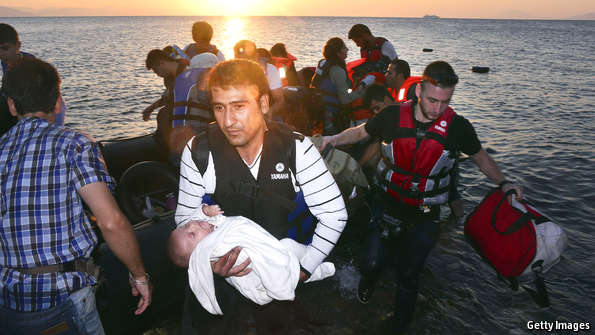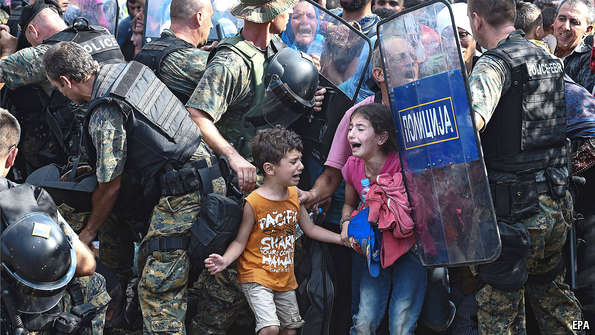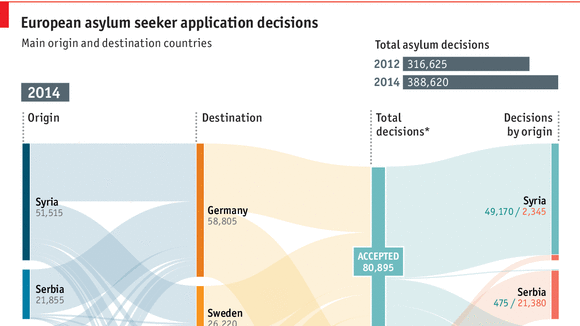

But migrants are adjusting their routes. The big change this year is the number entering Greece via short sea hops from Turkey. Syrians in particular have been put off the Italian route by the chaos in Libya and the dangers of the sea. The Greek government, which has other things on its mind (see article), needs help processing the arrivals and wants many to settle elsewhere. In May the European Commission proposed relocating 40,000 asylum-seekers from Greece and Italy to other EU countries (Britain, Denmark and Ireland have opt-outs from such matters), with national quotas determined by a formula incorporating population, GDP, unemployment and previous asylum bids and resettlements. But opposition from eastern Europeans and Spain squashed the plan.
Instead, most countries have volunteered to accept a certain number of relocated asylum-seekers, amounting to 32,256 over the next two years; the EU hopes to reach 40,000 by the end of the year. As with the original plan, eligibility is limited to migrants arriving in Italy and Greece from mid-April who hail from countries with asylum acceptance rates in Europe of over 75%: for now that means Syria, Eritrea and perhaps Iraq. The programme may be operational in October, though logistical problems could delay the start in Greece. Less controversially, European countries, working with the UN refugee agency, will resettle 22,504 people from outside Europe who already have refugee status. Most will probably be Syrians currently languishing in Jordan, Lebanon and Turkey.
These numbers are puny next to the scale of the problem: almost 50,000 asylum-seekers reached Greece in July alone. Some 4m Syrians have fled their homeland, not to mention the Sudanese, Somalis and others in camps in Africa who are also candidates for resettlement—or may decide to try their luck at the border. Yet by EU standards, this is progress: the Triton expansion and the relocation plan erode the notion that asylum-seekers are the sole responsibility of the country they reach first.
Europe has coped with emergencies before. The Yugoslav wars of the 1990s generated vast refugee flows that Germany and others were able to manage. After the Vietnam war France accepted around 100,000 boat people. Yet today many central and eastern European countries balk at calls to accept even a few hundred migrants. Some argue, plausibly, that new arrivals will simply up sticks as soon as they are relocated, exploiting the passport-free Schengen area to rejoin family in Sweden or find work in Germany. Poland’s government, facing re-election in October, is torn between a Europe demanding solidarity and a sceptical electorate; 70% oppose taking in asylum-seekers from Africa or the Middle East.
Some have more atavistic concerns. Slovakia wants Christian refugees only. Hungary’s prime minister, Viktor Orban, portrays his country as a doughty defender of European values in the face of an invasion by people from “different civilisational roots” and the “intellectual derangement” of liberals who want to let them in. His government is building a fence along the border with Serbia to keep out the wretches traipsing up from Greece and Macedonia. Ban-the-burqa debates have sprung up in the three Baltic states (combined population 6.2m), which together will accept 725 refugees.

Many easterners fear that outsiders will bring with them unwelcome values and habits. Some look at crime-ridden French banlieues or segregated Swedish cities like Malmo and see a future they wish to avoid. Finland shows how easily short-term refugees may become long-term residents. Thanks to family-reunification rules and the magnetic pull of the diaspora, there are now more than 16,000 Somalis in Finland, up from 49 in 1990, making them the country’s third-largest minority, after Russians and Estonians. Somalis account for one-quarter of asylum applicants in Finland this year, but just 2% across Europe.
It may seem fanciful to imagine Syrians or Eritreans putting down roots in Poznan or Presov. (It may not happen, if enough asylum-seekers break the terms of their relocation and move on.) But no doubt something similar could have been said about Helsinki three decades ago. Overwhelmed by the “Somali shock” in the early 1990s, and in the midst of recession, Finnish authorities had to improvise. Instant responses, like building reception centres and crackdowns on overt racism, gave way to integration policies such as language classes and measures to ease Somalis into the workforce.
Today the picture is mixed. Somalis tend to appreciate Finland’s peace and the freedom it affords their Muslim faith. Finland’s enlightened social-housing policy, which aims to ensure mixed neighbourhoods, stops or at least slows the development of Sweden-style ethnic ghettoes. But Finnish children with immigrant backgrounds struggle at school (see chart). In 2012, 38% of young Somali men in Helsinki were neither in work nor education. And Finnish identity has not, by and large, found space for the Somalis. Intermarriage is rare. Ambitious Somalis move abroad. When Finland’s biggest newspaper included her novel in a list of books to watch, Ms Farah’s delight quickly soured when she saw she had been described as Somali rather than Finnish.
Many easterners fear that outsiders will bring with them unwelcome values and habits. Some look at crime-ridden French banlieues or segregated Swedish cities like Malmo and see a future they wish to avoid. Finland shows how easily short-term refugees may become long-term residents. Thanks to family-reunification rules and the magnetic pull of the diaspora, there are now more than 16,000 Somalis in Finland, up from 49 in 1990, making them the country’s third-largest minority, after Russians and Estonians. Somalis account for one-quarter of asylum applicants in Finland this year, but just 2% across Europe.
It may seem fanciful to imagine Syrians or Eritreans putting down roots in Poznan or Presov. (It may not happen, if enough asylum-seekers break the terms of their relocation and move on.) But no doubt something similar could have been said about Helsinki three decades ago. Overwhelmed by the “Somali shock” in the early 1990s, and in the midst of recession, Finnish authorities had to improvise. Instant responses, like building reception centres and crackdowns on overt racism, gave way to integration policies such as language classes and measures to ease Somalis into the workforce.
Today the picture is mixed. Somalis tend to appreciate Finland’s peace and the freedom it affords their Muslim faith. Finland’s enlightened social-housing policy, which aims to ensure mixed neighbourhoods, stops or at least slows the development of Sweden-style ethnic ghettoes. But Finnish children with immigrant backgrounds struggle at school (see chart). In 2012, 38% of young Somali men in Helsinki were neither in work nor education. And Finnish identity has not, by and large, found space for the Somalis. Intermarriage is rare. Ambitious Somalis move abroad. When Finland’s biggest newspaper included her novel in a list of books to watch, Ms Farah’s delight quickly soured when she saw she had been described as Somali rather than Finnish.

Without much recent history of immigration to draw on, eastern European hosts will have to learn the lessons of integration quickly. The EU will pay countries €6,000 ($6,900) per asylum-seeker. But language lessons must be organised and reception centres prepared. Schools have to make specific provisions for children, some of them traumatised, while helping them integrate with their peers. Citizens living near reception centres will need reassuring. NGOs must be mobilised. Perhaps most importantly, governments must ease the passage of adults into the workplace, the best motor of integration. This might mean tinkering with laws. All this takes planning and political will. “You need to start yesterday,” says Annika Forsander, who ran Helsinki’s integration office for seven years.
Yet few eastern European governments have an interest in seeing the experiment succeed. For if it does, Brussels will have a better chance of pushing through a mandatory relocation scheme; the commission plans to revive the idea, with a few tweaks, early next year. Why might the second plan succeed when the first flopped? Pressure from Germany, groaning under an expected 800,000 asylum claims this year, is one reason. Angela Merkel, the chancellor, describes the migrant crisis as “the next great European project”. This week she teamed up with François Hollande, the French president, to urge action; a sure sign she wants to get something done.
Logistically the Germans will cope with their migrants, thanks in part to an efficient domestic relocation plan that helped inspire the EU version. But the government frets about a political backlash; thugs have torched lots of refugee homes and the moans from regional officials are growing louder. The EU’s relocation plan is presented as a way to relieve Italy and Greece, but it may also be an effort to reduce the burden on Germany and other popular destinations, such as Sweden and Austria. Further rows lie ahead.
The tough approaches some governments take to illegal immigration spring from a reasonable concern: they want to choose their migrants rather than the other way around. Economic migrants and asylum-seekers journey together. Often they are the same people—a Syrian refugee may wish both to avoid decapitation and to earn higher wages. (Still, nearly two-thirds of the migrants to reach Europe this year are from countries so dangerous that their nationals are usually granted asylum.) Security services must be alert to the possibility of terrorists exploiting well-trodden migration channels. Assembling fences, mobilising troops and dispatching drones is therefore tempting. Yet it sits awkwardly with Europeans’ self-imposed obligation to offer protection to anyone with a well-grounded fear of persecution. And it often merely displaces the problem from one country to another.
Some officials speak of tackling the networks that enable migrants to make their epic journeys across deserts and mountains. The best hope, many argue, is to convince so-called “countries of origin” to crack down on smugglers. Yet ruthless as they may be, smugglers are meeting a demand, and plenty of transit countries enjoy the economic activity they bring.
As outsiders appear ever more desperate to enter Europe, its residents seem ever-keener to keep them out. A recent Eurobarometer poll found immigration at the top of voters’ concerns for the first time in the survey’s 42-year history. Populist parties with anti-immigrant streaks are on the rise: last week the Sweden Democrats, a nationalist party with neo-Nazi roots, topped a poll in Sweden. It is hard to imagine a policy that would play into the hands of such outfits better than a diktat from Brussels to accept more Muslim refugees. Last month Olli Immonen, a potty-mouthed Finnish MP, called on his countrymen to “defeat this nightmare called multiculturalism” (foreigners account for 5.9% of the Finnish population). Finland’s Somalis say the climate has grown frosty.
To help secure the support of voters for more generous asylum rules, EU officials still have cards up their sleeves. Next year they will review the Dublin rule, which in theory obliges asylum-seekers to make their claims as soon as they enter Europe; in practice it is a shambles. The EU also promises to clamp down on Italian and Greek officials, who are supposed to register asylum-seekers on arrival but tend to nod most through. Another tool is to expedite the processing of asylum-seekers from peaceful countries, notably the Balkan states. This is a particular concern for Germany: this year it has received more than twice as many asylum-seekers from Albania, Kosovo, Macedonia and Serbia as from Syria. Almost all of their claims are rejected, but in the meantime they must be fed, housed and otherwise supported. Mr Hollande and Mrs Merkel have backed an EU plan for a common “safe country” list.

In the longer term, leaders will have to talk to their people about
demography. Within ten years, according to Bruegel, an economic
think-tank, Europe’s labour force will start shrinking. Africa,
meanwhile, is growing apace; by 2050, the UN projects that its
population will be well over three times that of Europe, up from around
1.5 times as big today, and far younger. Europe could do with some
sprightly immigrants to boost its tax base and pay for its growing army
of pensioners.
Yet the scale of migration needed to tilt Europe’s demographic curve
is way beyond what voters might accept. Nor will skill gaps necessarily
be met by arrivals from developing countries, however enterprising.
Other ideas are thin on the ground. Guest-worker programmes have fallen
out of fashion. The EU’s “blue card” for highly skilled non-European
migrants is a flop; bar Germany, European countries have stuck with
their own labour-migration schemes. (The EU is promising a rethink.)Hope nonetheless
Amid all the wrangling, one should not overlook the benefits to migrants, even if they emerge in unexpected ways. Fadumo Dayib, who arrived in Finland in 1990, speaks extremely warmly of her adopted nation, but to fulfil her ambitions she had to move on somewhere else. Having spent the past year studying at Harvard she is now planning to run for the presidency of Somalia. Even migrants who struggle to take on their adopted homeland’s identity are surprised to find it suddenly materialise when they travel. A few years ago Ms Farah visited London but, confronted with its bustle and noise, found herself craving the quiet of her Helsinki suburb.




No comments:
Post a Comment